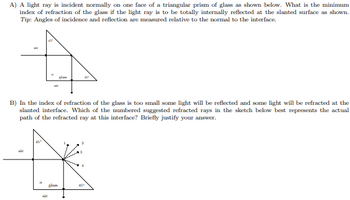Question

Transcribed Image Text:A) A light ray is incident normally on one face of a triangular prism of glass as shown below. What is the minimum
index of refraction of the glass if the light ray is to be totally internally reflected at the slanted surface as shown.
Tip: Angles of incidence and reflection are measured relative to the normal to the interface.
B) In the index of refraction of the glass is too small some light will be reflected and some light will be refracted at the
slanted interface. Which of the numbered suggested refracted rays in the sketch below best represents the actual
path of the refracted ray at this interface? Briefly justify your answer.
air
11
glass
45"
air
450
Expert Solution
This question has been solved!
Explore an expertly crafted, step-by-step solution for a thorough understanding of key concepts.
This is a popular solution
Trending nowThis is a popular solution!
Step by stepSolved in 5 steps with 23 images

Knowledge Booster
Similar questions
- Light incident in a medium with an index of refraction 1.47 encounters a medium with an index of refraction 1.18. Which of the following best describes what can happen? If there isn't total internal reflection, then the light that refracts into the second medium bends away from the normal. There will never be total internal reflection and the light that refracts into the second medium will bend away from the normal. If there isn't total internal reflection, then the light that refracts into the second medium bends towards the normal. There can only be total internal reflection.arrow_forwardWhat happens to a light wave when it hits a surface that has a higher index of refraction? a) It reflects with λ/2 phase shift. b) It reflects with a λ/4 phase shift. c) It's shift is porportional to the angle of reflection. d) It reflects with it's phase unshifted.arrow_forwardA beam of light enters a flint glass semicircular disk with an index of refraction of ng = 1.66 at the midpoint of the flat side as shown in the figure. Determine the angle of incidence in air such that the refracted light will travel through the glass along a normal to the semicircular surface and hit a projection screen with the coordinates x = 5.50 cm and y = 18.1 cm. =___°arrow_forward
- As shown in the figure, a light beam travels from air, through olive oil, and then into water. If the angle of refraction 0, for the light in the olive oil is 29.6°, determine the angle of incidence 0, in air and the angle of refraction 03 in water. The index of refraction for olive oil is 1.47. 0, = 83 = air n2 oil 13 waterarrow_forwardA beam of light is incident from a liquid on the surface of transparent solid. The angle of incidence is 30°and the angle of refraction is 18°. Draw clear physics diagram of the problem – one for each part of the problem (3 total). label relevant angles. Find the critical angle for this solid when it is surrounded by the liquid. What is the angle between the reflected and refracted rays when the angle of incidence is 3°less than the critical angle?arrow_forwardFigure 3 shows a beam of light incident on a glass plate of thickness d and index of Air Glass T Air refraction (a) Find the angle of incidence so that the perpendicular separation between the ray reflected from the top surface and the ray reflected from the bottom surface and exiting the top surface is a maximum.(show all steps clearly) (b) What is this angle of incidence if the index of refraction of the glass is 1.54? (c) (c) What is the separation of the two beams if the thickness of the glass plate is 5.5 cm?arrow_forward
- As shown in the figure, a light beam travels from air, through olive oil, and then into water. If the angle of refraction 82 for the light in the olive oil is 34.8°, determine the angle of incidence e, in air and the angle of refraction e3 in water. The index of refraction for olive oil is 1.47. 83 = air oil waterarrow_forwardUse the exact values you enter to make later calculations.A ray of light strikes a flat, 2.00-cm-thick block of glass (n = 1.96) at an angle of ? = 32.4° with respect to the normal (see figure below). A light ray incident on a glass block of thickness 2.00 cm is shown. The ray travels down and to the right and is incident to the top of the block at an angle ? to the normal of the surface. The ray inside the block moves down and to the right but at a steeper slope than the incident ray. It is incident on the bottom surface of the block and exits moving down and to the right, in the same direction as the incident ray. A dashed line extends from the original path of the ray down in the block and is shown to be a distance d from the ray that exits the glass block. (a) Find the angle of refraction at the top surface and the angle of incidence at the bottom surface. °(b) Find the refracted angle at the bottom surface. °(c) Find the lateral distance d by which the light beam is shifted. cm(d)…arrow_forwardA beam of light is incident on a square piece of glass with side s = 10.0 cm and index of refraction 1.50. The angles are shown in the figure to scale (you can count the blocks to measure them if you don't have a protractor). Where does the beam exit the glass? Assume the glass is in air (n = 1.00).arrow_forward
arrow_back_ios
arrow_forward_ios